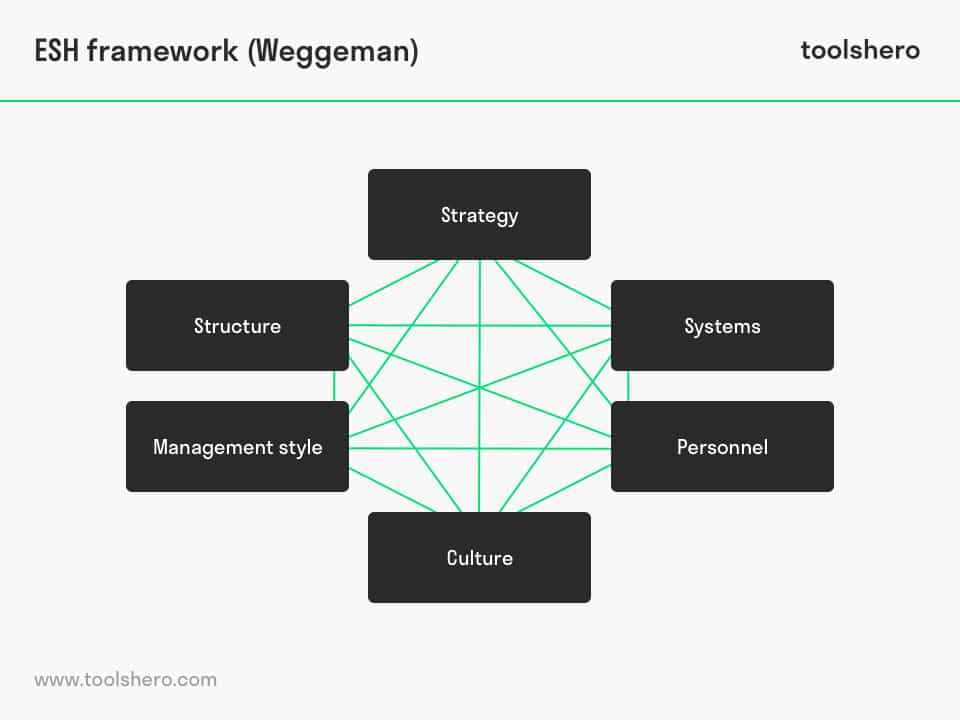ESH framework (Weggeman)

ESH framework: this article explains the ESH framework by Mathieu Weggeman in a practical way. After reading you will understand the basics of this powerful problem solving tool.
What is the ESH framework?
In professional organizations that have the ability to change, the right knowledge is found in the right place so that the right decision can be made at any level in the organization.
However, organizations undergoing such a change process, will always have to take the following six components into account: strategy, systems, personnel, culture, management styles and structure.
The Dutch organizational expert Mathieu Weggeman has developed the ESH framework for this purpose. ESH is an acronym and stands for Evenwicht (Balance), Samenhang (Cohesion) and Heterogenity.
ESH framework for analyses
The ESH framework is based on McKinsey’s 7S framework and looks at organizations in their totality.
Balance
In the ESH framework all components / elements are equally important. Therefore, “structure” is not more important than “personnel”. Each component requires a pro rata amount of time, energy and attention from managers.
Cohesion
There is cohesion and interdependence between the six components. When one component is changed, this will immediately affect the other five components. These organization variables must be properly coordinated.
Heterogeneity
The ESH framework is heterogeneous. The content of the components varies. There are differences between formal and informal, between internal and external and between time and place. On the one hand a manager works in a formal manner by using an assessment form, and on the other hand he works informally when he wants to speak to an employee in private.
Balance in the DOR model
The ESH framework forms an important part of the DOR model; Targets (D), Organization (O) and Realization(R). The ESH framework focuses specifically on organizational change. The following six components are important in this:
Strategy
What are the predetermined organizational objectives, how are they pursued and what resources are available and required?
Systems
What rules and procedures are required to be able to function in an organization on a daily basis?
Personnel
How expert, driven, independent and loyal is personnel? What specialities are there in an organization? Are employees being deployed in the right positions?
Culture
What common standards and values are there in the organization and how are these standards and values expressed?
Management style
What management styles are prevailing in the organization?
Structure
How is the division of tasks, responsibilities and authorities in an organization?
Change
Each change trajectory must take these six components into account. Organizations are forced to change more and more often because of external factors. This requires a flexible attitude, in which the balance between the six components must be found and recovered. By anticipating these, an organization will be able to go along with the changes, without too many far-reaching consequences.
If you liked this article, then please subscribe to our Free Newsletter for the latest posts on models and methods.
More information
- Ernest-Jones, T, (2005). Know How: Managing Knowledge for Competitive Advantage. The Economist Intelligence Unit, June 2005, pp. 1-21.
- Weggeman, M. (2000). Kennismanagement: de praktijk. Scriptum, Schiedam, the Netherlands.
- Weggeman, M. (1997) Kennismanagement: inrichting en besturing van kennisintensieve organisaties. Scriptum, Schiedam, the Netherlands.
How to cite this article:
Van Vliet, V. (2013). ESH framework by Mathieu Weggeman. Retrieved [insert date] from toolshero: https://www.toolshero.com/problem-solving/esh-framework-weggeman/
Add a link to this page on your website:
<a href=”https://www.toolshero.com/problem-solving/esh-framework-weggeman/”>toolshero: ESH framework by Mathieu Weggeman</a>
Published on: 23/09/2013 | Last update: 04/03/2022






